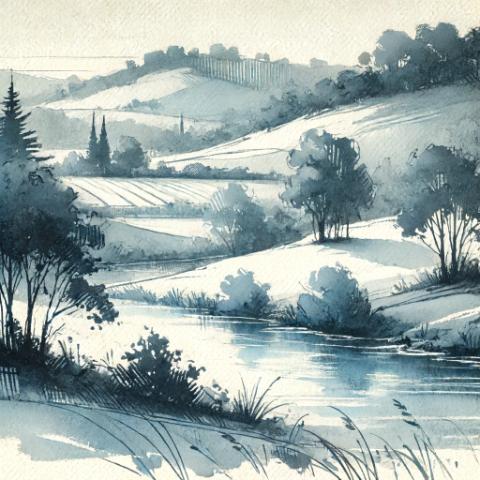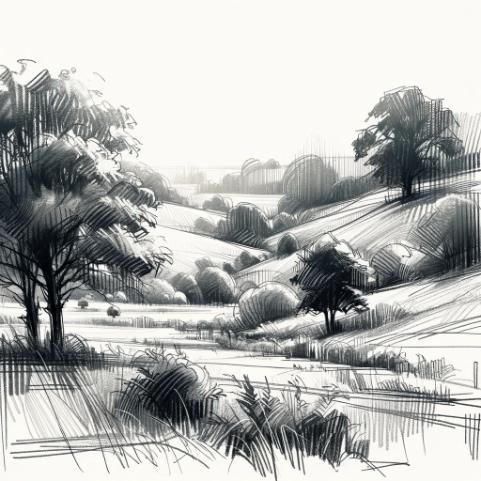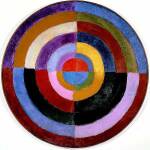Monochrome art, derived from the Greek words “mono” meaning single and “chroma” meaning color, refers to artworks created using only one color or variations of a single hueIn color theory, hue is one of the main properties of a color, defining its dominant wavelength. This characteristic determines whether we perceive a color as red, orange, yellow, green, blue, or violet. Understanding hue is essential for artists, designers, and anyone working with color. Defining Hue • Definition: Hue is the degree to which a color can be described More. This approach emphasizes the use of tonesIn color theory, a tone is a version of a color created by adding gray (a mix of black and white) to the original hue. This concept is essential for artists and designers as it allows for a wide range of colors that are neither too dark nor too light, providing versatility in creating depth, mood, and harmony within a More, tints, and shadesIn color theory, a shade is a darker version of a color, created by adding black to the original hue. This concept is essential for artists and designers, as it allows for a range of deeper, more intense tones that can add depth and drama to a composition. Defining Shade A shade results from mixing a pure hue with black. More of one color to create depth, texture, and contrast. Monochrome art can be powerful in its simplicity, drawingDrawing is a foundational art form that involves creating images on a surface, typically paper, using tools such as pencils, pens, and charcoal. It is a versatile medium that allows artists to express ideas, emotions, and stories through lines, shapes, and shading. Historical Background • Prehistoric Beginnings: The earliest known drawings date back to prehistoric times, with cave drawings found More the viewer’s attention to composition, form, and technique.
Defining Monochrome
Monochrome art is characterized by the use of a single color throughout the composition. This single color can be manipulated through various methods to achieve different visual effects.
- Example: An artist might create a monochrome paintingPainting is a fundamental form of visual art that has been practiced for thousands of years. It involves applying pigment to a surface such as canvas, paper, or a wall. Painting can be explored through various styles, techniques, and mediums, each offering unique possibilities for expression and creativity. Historical Background • Ancient Beginnings: The history of painting dates back to More in shadesIn color theory, a shade is a darker version of a color, created by adding black to the original hue. This concept is essential for artists and designers, as it allows for a range of deeper, more intense tones that can add depth and drama to a composition. Defining Shade A shade results from mixing a pure hue with black. More of blue, using different values of blue to depict light and shadow.
- Variations: Tints (adding white), tonesIn color theory, a tone is a version of a color created by adding gray (a mix of black and white) to the original hue. This concept is essential for artists and designers as it allows for a wide range of colors that are neither too dark nor too light, providing versatility in creating depth, mood, and harmony within a More (adding gray), and shadesIn color theory, a shade is a darker version of a color, created by adding black to the original hue. This concept is essential for artists and designers, as it allows for a range of deeper, more intense tones that can add depth and drama to a composition. Defining Shade A shade results from mixing a pure hue with black. More (adding black) are used to create a range of values within the chosen color.

Importance of Monochrome in Art
Monochrome art strips away the distraction of multiple colors, allowing viewers to focus on other aspects of the artwork such as composition, texture, and form. This technique can enhance the emotional and psychological impact of a piece.
- Focus on Form and Composition: Without the interplay of different colors, the viewer’s attention is drawn to the shapes, lines, and structure of the artwork.
- Emotional Impact: Monochrome art can evoke strong emotional responses through the use of light and dark contrasts within a single color range.
- Technical Mastery: Creating depth and interest using only one color requires a high level of skill and understanding of valueIn color theory, value refers to the lightness or darkness of a color. This concept is crucial for artists and designers because it helps create depth, contrast, and visual interest in their work. Value is one of the three properties of color, alongside hue and saturation. Defining Value Value indicates how light or dark a color appears. It ranges from More and texture.

Monochrome in Different Art Forms
Monochrome techniques can be applied across various art forms, each bringing its own unique challenges and possibilities.
- PaintingPainting is a fundamental form of visual art that has been practiced for thousands of years. It involves applying pigment to a surface such as canvas, paper, or a wall. Painting can be explored through various styles, techniques, and mediums, each offering unique possibilities for expression and creativity. Historical Background • Ancient Beginnings: The history of painting dates back to More: Artists often use monochrome palettes to explore light and shadow, create atmospheric effects, or focus on the subject matter’s emotional resonance.
- Photography: Monochrome photography, typically in black and white, emphasizes contrast, texture, and composition. This style is celebrated for its timeless quality and dramatic effect.
- DrawingDrawing is a foundational art form that involves creating images on a surface, typically paper, using tools such as pencils, pens, and charcoal. It is a versatile medium that allows artists to express ideas, emotions, and stories through lines, shapes, and shading. Historical Background • Prehistoric Beginnings: The earliest known drawings date back to prehistoric times, with cave drawings found More: In monochrome drawingDrawing is a foundational art form that involves creating images on a surface, typically paper, using tools such as pencils, pens, and charcoal. It is a versatile medium that allows artists to express ideas, emotions, and stories through lines, shapes, and shading. Historical Background • Prehistoric Beginnings: The earliest known drawings date back to prehistoric times, with cave drawings found More, artists use a single medium, such as charcoalCharcoal is a popular and expressive medium used in drawing. Known for its deep blacks and range of tones, charcoal allows artists to create dramatic and dynamic artworks with a distinct, textured look. Historical Background • Ancient Beginnings: Charcoal has been used since prehistoric times, with early humans using burnt sticks to create drawings on cave walls. These early works More, graphite, or inkInk, a liquid or paste used for writing, drawing, and printing, has played a crucial role in communication and artistic expression throughout history. Made from various pigments and dyes, ink allows for the transfer of text and images onto surfaces such as paper, fabric, and other materials. Types of Ink There are several types of ink, each serving different purposes More, to create detailed and nuanced works.
- Printmaking: Monochrome printmaking can highlight intricate details and textures that might be overshadowed in multicolored prints.

Techniques for Effective Monochrome Art
Several techniques help artists create compelling monochrome artworks.
- ValueIn color theory, value refers to the lightness or darkness of a color. This concept is crucial for artists and designers because it helps create depth, contrast, and visual interest in their work. Value is one of the three properties of color, alongside hue and saturation. Defining Value Value indicates how light or dark a color appears. It ranges from More Control: Manipulating the lightness and darkness of the chosen color to create depth and contrast. Artists must skillfully balance these values to avoid a flat appearance.
- Texture and Pattern: Adding texture through brushstrokes, cross-hatching, or other methods to enhance the visual interest and depth of the artwork.
- LayeringLayering is a fundamental technique in art that involves building up multiple layers of material to create depth, texture, and complexity in a composition. This approach is used in various art forms, including painting, drawing, digital art, and mixed media. Layering allows artists to add richness and dimension to their work, making it more dynamic and engaging. Defining Layering Layering More: Building up layers of the same color to create rich, varied tonesIn color theory, a tone is a version of a color created by adding gray (a mix of black and white) to the original hue. This concept is essential for artists and designers as it allows for a wide range of colors that are neither too dark nor too light, providing versatility in creating depth, mood, and harmony within a More and subtle transitions between light and dark areas.
Historical Use of Monochrome
Monochrome art has a rich history, with artists across different periods and styles employing this technique to various ends.
- Renaissance: Artists like Leonardo da Vinci used monochrome sketches and studies (often in sepia or sanguine) to explore form and anatomy.
- MinimalismMinimalism is an art movement that emerged in the late 1950s and early 1960s, primarily in the United States. It is characterized by its use of simple geometric forms, clean lines, and a focus on the materiality of the work itself. Minimalist art emphasizes simplicity and seeks to strip away any unnecessary elements to reveal the essence of the artwork. More: Minimalist artists such as Yves Klein and Ad Reinhardt used monochrome to strip down art to its essentials, focusing on color and form without the distraction of multiple hues.
- Contemporary Art: Modern artists continue to explore monochrome, using it to create striking, meditative, or challenging works that push the boundaries of how we perceive color and form.
Challenges with Monochrome
Working in monochrome presents unique challenges that require a deep understanding of color theoryColor Theory is a comprehensive framework used to understand and analyze the use and interaction of colors in visual compositions. It serves as a critical guide for artists, designers, and marketers, helping them create harmonious and effective designs. This concept encompasses various principles and elements that dictate how colors are combined, perceived, and utilized. Primary Colors: • The three foundational More, valueIn color theory, value refers to the lightness or darkness of a color. This concept is crucial for artists and designers because it helps create depth, contrast, and visual interest in their work. Value is one of the three properties of color, alongside hue and saturation. Defining Value Value indicates how light or dark a color appears. It ranges from More, and texture.
- Maintaining Interest: Keeping the viewer engaged without the use of multiple colors can be difficult. Artists must rely on composition, texture, and valueIn color theory, value refers to the lightness or darkness of a color. This concept is crucial for artists and designers because it helps create depth, contrast, and visual interest in their work. Value is one of the three properties of color, alongside hue and saturation. Defining Value Value indicates how light or dark a color appears. It ranges from More to maintain interest.
- ValueIn color theory, value refers to the lightness or darkness of a color. This concept is crucial for artists and designers because it helps create depth, contrast, and visual interest in their work. Value is one of the three properties of color, alongside hue and saturation. Defining Value Value indicates how light or dark a color appears. It ranges from More Balance: Ensuring a balanced range of values to create depth and avoid flatness is crucial. Overemphasis on one valueIn color theory, value refers to the lightness or darkness of a color. This concept is crucial for artists and designers because it helps create depth, contrast, and visual interest in their work. Value is one of the three properties of color, alongside hue and saturation. Defining Value Value indicates how light or dark a color appears. It ranges from More range can make the artwork look monotonous.
- Texture and Detail: Without color variety, texture and fine details become more important in conveying the subject matter and maintaining viewer engagement.
Applications of Monochrome in Modern Art
Monochrome remains a powerful tool in contemporary art, offering a range of expressive possibilities.
- Abstract Art
%22%20transform%3D%22translate(.5%20.5)%22%20fill-opacity%3D%22.5%22%3E%3Cellipse%20fill%3D%22%23fff%22%20rx%3D%221%22%20ry%3D%221%22%20transform%3D%22rotate(49.5%20-73.5%20216.4)%20scale(22.32723%2041.18916)%22%2F%3E%3Cellipse%20fill%3D%22%2360313a%22%20cx%3D%2272%22%20cy%3D%2276%22%20rx%3D%2261%22%20ry%3D%2261%22%2F%3E%3Cellipse%20fill%3D%22%23fff%22%20rx%3D%221%22%20ry%3D%221%22%20transform%3D%22rotate(-131.7%2070.2%20-26.1)%20scale(108.88858%2017.91884)%22%2F%3E%3Cellipse%20fill%3D%22%23fff%22%20rx%3D%221%22%20ry%3D%221%22%20transform%3D%22rotate(-131.1%2036.5%2066.6)%20scale(60.55413%2017.0478)%22%2F%3E%3C%2Fg%3E%3C%2Fsvg%3E) Abstract artworks diverge from depicting recognizable scenes or objects and instead use colors, forms, and lines to create compositions that exist independently of visual references from the natural world. This movement, which gained momentum in the early 20th century, was propelled by artists such as Wassily Kandinsky, Piet Mondrian, and Kazimir Malevich. These artists aimed to explore spiritual, emotional, and More: Many abstract artists use monochrome palettes to focus on form, texture, and the emotional impact of a single color.
Abstract artworks diverge from depicting recognizable scenes or objects and instead use colors, forms, and lines to create compositions that exist independently of visual references from the natural world. This movement, which gained momentum in the early 20th century, was propelled by artists such as Wassily Kandinsky, Piet Mondrian, and Kazimir Malevich. These artists aimed to explore spiritual, emotional, and More: Many abstract artists use monochrome palettes to focus on form, texture, and the emotional impact of a single color. - Portraiture: Monochrome portrait artists use varying tonesIn color theory, a tone is a version of a color created by adding gray (a mix of black and white) to the original hue. This concept is essential for artists and designers as it allows for a wide range of colors that are neither too dark nor too light, providing versatility in creating depth, mood, and harmony within a More to capture the essence of their subjects, emphasizing light and shadow.
- Landscape Art: Monochrome landscapes can evoke specific moods, such as the tranquility of a foggy morning or the stark beauty of a winter scene.
Visualizing Monochrome
To fully appreciate monochrome art, it is helpful to examine visual aids and real-life examples.
- Comparative Studies: Comparing monochrome and multicolored versions of the same subject can highlight the impact of a single color paletteA color palette refers to a selection of colors used in design and art. It can set the tone, convey emotions, and highlight key elements. color wheel Types of Color Palettes • Monochromatic: Uses variations in lightness and saturation of a single color. Ideal for creating a harmonious and cohesive look. • Analogous: Combines colors that are next to each More.
- Process Documentation: Step-by-step documentation of creating a monochrome artwork can illustrate how artists achieve depth and texture using one color.
- Gallery Examples: Visiting galleries or viewing collections of monochrome works can provide insights into the variety and richness achievable within this approach.
Understanding monochrome and its applications allows artists and designers to expand their creative possibilities and focus on the fundamental elements of their work. This technique emphasizes the power of valueIn color theory, value refers to the lightness or darkness of a color. This concept is crucial for artists and designers because it helps create depth, contrast, and visual interest in their work. Value is one of the three properties of color, alongside hue and saturation. Defining Value Value indicates how light or dark a color appears. It ranges from More, texture, and composition, offering a unique and often profound visual experience.
Read more about color theoryColor Theory is a comprehensive framework used to understand and analyze the use and interaction of colors in visual compositions. It serves as a critical guide for artists, designers, and marketers, helping them create harmonious and effective designs. This concept encompasses various principles and elements that dictate how colors are combined, perceived, and utilized. Primary Colors: • The three foundational More here:
Color Theory Simplified: Make Your Art Stand Out with These Easy Tips
Mastering Color Theory: Watercolor Hacks for Vibrant Palettes
Mastering Art with Color Theory: Kandinsky’s Transformative Vision

